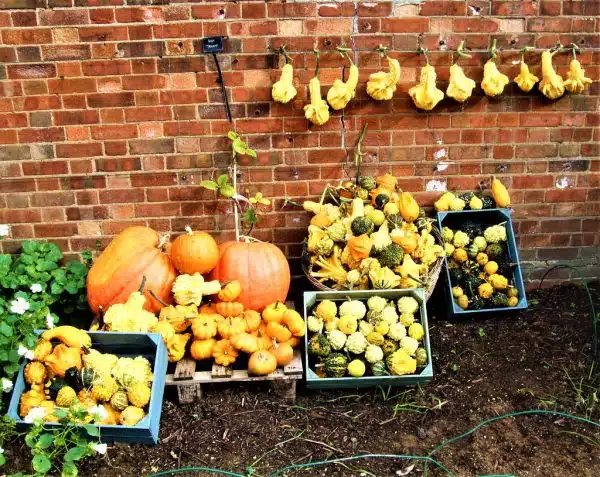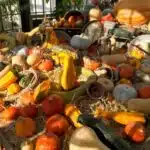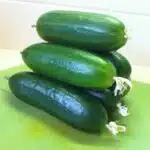Ornamental gourds have been grown and used for decorative purposes for centuries. These colorful, unique fruits come in a variety of shapes and sizes, making them a desirable addition to any autumnal arrangement or harvest display. However, harvesting and drying ornamental gourds can be a bit tricky for those who are new to gardening or unfamiliar with the process.
To ensure that your ornamental gourds are properly harvested and dried, it is important to understand the proper techniques involved in this process. From choosing the right time to harvest to properly curing and storing your gourds, there are several steps that must be taken in order to ensure that your ornamental gourds remain beautiful and intact throughout the season. This article will provide an overview of these steps and offer tips for achieving success when harvesting and drying ornamental gourds.
Understanding The Life Cycle Of Ornamental Gourds
Growing ornamental gourds is a rewarding experience for gardeners and horticultural enthusiasts alike. Understanding the life cycle of these plants is crucial to ensure a bountiful harvest and successful drying process. Ornamental gourds are members of the Cucurbitaceae family, along with squash, pumpkins, and cucumbers. These plants start their life as seeds that require warm temperatures and fertile soil to germinate.
Understanding gourd pollination is important when growing these plants. Gourds must be pollinated by bees or other insects to develop fully. The female flowers of the plant have a small fruit attached at their base, which will grow into a mature gourd once fertilized. It’s important to note that not all flowers on the plant will bear fruit, so it’s essential to keep an eye out for the ones that do. Once pollinated, most types of ornamental gourds take approximately 90-120 days to reach maturity.
Identifying ripe gourds is critical when harvesting them for drying purposes. When harvesting gourds, look for firm fruit with hard skin that has lost its shine and has turned dull in color. A ripe gourd should also sound hollow when tapped gently with your hand or a stick. When harvesting them from the vine, use sharp shears or pruning knives to prevent damage to both the fruit and the plant itself. Remember that immature fruits won’t dry properly and can rot during storage, so it’s best to wait until they’re ready before picking them off from the vine.
Knowing how to identify ripe ornamental gourds is critical when planning their harvest and subsequent drying process. After understanding how these plants grow and develop over time, choosing the right varieties for harvesting and drying becomes an essential next step in ensuring success in this process.
Choosing The Right Varieties For Harvesting And Drying
Variety selection is an important aspect of harvesting and drying ornamental gourds. Some varieties are better suited for this purpose than others. For instance, the Bottle, Dipper, and Apple varieties are popular choices as they tend to be larger in size and have hard, thick shells that dry well. Additionally, the Warted Mix variety is a favorite among many growers due to its unique shapes and colors.
Harvesting timing is also crucial when it comes to drying ornamental gourds. The ideal time to harvest them is when the vines start turning brown and withering away. This is usually around late September or early October for most varieties. It’s important not to wait too long as over-ripe gourds can start rotting or cracking, which will affect their ability to dry properly.
When selecting varieties for harvesting and drying, it’s essential to consider both their physical attributes and maturity timelines. By doing so, you’ll ensure that you have a bountiful harvest of healthy gourds that will dry well. With the right variety selection and appropriate harvesting timing in mind, your next step should be planning your harvesting schedule to ensure optimal results.
Planning Your Harvesting Schedule
As gardeners, we all know that harvesting is one of the most exciting times of the year. It’s a time to reap the fruits of our labor and enjoy the bountiful harvest that Mother Nature has provided. However, when it comes to ornamental gourds, timing is everything. To ensure a successful harvest, you need to have a solid plan in place.
The first step in planning your harvesting schedule is to determine when your gourds are ready for picking. This will depend on the variety you are growing and the climate you are in. Generally speaking, ornamental gourds are ready for harvesting when their stems have turned brown and dried out. You can also give them a tap – they should sound hollow.
Once you have determined that your gourds are ready for picking, it’s time to consider the weather conditions. Ideally, you want to pick your gourds on a dry day when there is no risk of rain or frost. Moisture can cause your gourds to rot, while frost can damage their skins and ruin their appearance. If you live in an area with unpredictable weather patterns, it may be worth investing in some protective covers or bringing your gourds indoors until the weather improves.
Moving forward, now that you have planned out when to harvest your ornamental gourds based on timeline and weather considerations, let’s discuss the tools and materials you will need for this task.
Tools And Materials You Will Need
- Pruning shears are essential for harvesting ornamental gourds, as they ensure a clean cut and reduce the risk of disease.
- A gourd brush can be used to clean off any soil that may remain on the gourd after harvesting.
- A bucket is necessary to store the harvested gourds until they are ready to be dried.
- Rope or twine can be used to tie the gourds to a drying rack or other support structure.
- A saw, hammer and nail, drill, and sandpaper can all be used to create holes in the gourds for decorative purposes.
- Paintbrushes, straw, wire, drying racks, and cardboard are all useful materials and tools for drying ornamental gourds.
Pruning Shears
Harvesting and drying ornamental gourds can be a fun and rewarding activity for gardeners. However, to ensure a successful harvest, it is important to have the right tools on hand. One essential tool for this task is pruning shears. Using pruning shears can help you carefully cut the gourds from the vine without damaging them.
When selecting pruning shears for ornamental gourd harvest, there are a few things to keep in mind. First, choose a pair with sharp blades that can easily slice through the thick stems of the gourd vines. Look for models with ergonomic handles that fit comfortably in your hand and won’t cause strain during use. Additionally, consider the size of the pruning shears; smaller models may be more suitable for precise cuts while larger ones may provide more leverage for tougher cuts.
Using pruning shears effectively requires some tips and techniques. To start, always make clean cuts by positioning the blades at an angle rather than straight across the stem. This helps prevent crushing or tearing of the remaining vine tissue which could lead to damage or disease spread. Also, be sure to sanitize your pruning shears between cuts using rubbing alcohol or bleach solution to prevent contamination between plants. With proper selection and use of pruning shears, harvesting ornamental gourds can be a satisfying experience!
Gourd Brush
Now that we have covered the importance of pruning shears in harvesting and drying ornamental gourds, let’s move on to another essential tool – the gourd brush. Gourd brushes are small, stiff-bristled brushes that can be used to clean and polish ornamental gourds. They are particularly useful for removing dirt, debris, and any remaining bits of stem from the surface of the gourd.
When selecting a gourd brush, look for one with firm bristles that won’t bend or break easily. You may also want to consider the size of the brush; smaller brushes are ideal for cleaning hard-to-reach areas or intricate designs on the gourds. If you don’t have a specific gourd brush on hand, there are several DIY alternatives you can try. A toothbrush or nail brush can work just as well in a pinch.
To effectively use a gourd brush, start by gently brushing over the entire surface of the gourd to remove any loose dirt or debris. Then, focus on any stubborn spots or areas where stem remnants remain attached. Be careful not to scrub too hard as this could damage the surface of the gourd. For tough spots, try using a bit of mild soap and water along with your brush for added cleaning power.
In conclusion, having a good quality gourd brush is an important part of your tools and materials needed for harvesting and drying ornamental gourds. With proper cleaning tips and techniques, you can ensure your gourds remain in pristine condition throughout their display season. Remember to take care when using any tools when handling delicate plants such as these beautiful decorative fruits!
Bucket
Now that we have covered the importance of pruning shears and gourd brushes, let’s move on to another essential tool in harvesting ornamental gourds – the bucket. When it comes to harvesting gourds, using a bucket can be a great choice for several reasons. First, it allows you to easily collect your harvest without damaging the delicate fruits. Second, using a bucket keeps the gourds organized and prevents them from rolling around and getting damaged.
When selecting a bucket for gourd harvesting, choose one with a wide mouth to make it easy to toss in the fruit as you pick them. A sturdy handle is also important as it will help you carry your harvest without any issues. Once you have finished harvesting, make sure to clean and maintain your buckets properly. This will not only prolong their lifespan but also prevent contamination of future harvests.
Bucket cleaning and maintenance are essential steps in ensuring that they remain free from dirt and debris buildup that can harbor harmful bacteria or fungi that can damage your crops. After each use, rinse out your buckets thoroughly with water to remove any remaining dirt or plant debris. For stubborn stains or residue buildup, use a mild soap solution to scrub the interior of the bucket gently. Rinse again with water before allowing it to air dry completely. By taking these simple steps after each use, you can keep your buckets clean and ready for their next use.
In conclusion, using a bucket for harvesting is an excellent way to keep your ornamental gourds safe and organized during the harvest season. Remember that proper cleaning and maintenance are key elements in ensuring that your buckets last longer while keeping them free from harmful contaminants that could affect future crops. With these tips in mind, you’ll be well on your way to having a successful harvest season!
Preparing Your Gourds For Harvesting
Pre harvest preparation is an important factor in ensuring a bountiful harvest of ornamental gourds. Before harvesting, it is crucial to check if the gourds have reached their maturity stage. Gourds are mature when they have hard shells and a dry stem. The ideal time to harvest ornamental gourds is when the vines start to die down and the leaves begin to turn yellow.
Once you have confirmed that your gourds are ready for harvesting, it’s time to prepare them for the process. Start by pruning any remaining foliage around the gourd’s stem, leaving only a few inches of stem attached to the fruit. This will prevent rotting from occurring after harvesting. After pruning, use a pair of sharp garden shears or scissors to cut the fruit from the vine, making sure not to damage its skin.
Harvesting techniques play a vital role in ensuring that you obtain high-quality ornamental gourds. To avoid any damage during harvesting, handle each fruit with care while cutting it from its vine and place it gently in a basket or container. Once all your gourds are harvested, store them in an area with good ventilation and low humidity until they dry completely.
- Keep your ornamental gourds in a cool place out of direct sunlight.
- Clean your tools before harvesting every other plant.
- Wipe off any dirt or debris on the surface of the fruit before storing.
- Do not stack your harvested fruits; instead, keep them separate from each other.
- If you notice any signs of decay or mold on your fruits during storage, discard them immediately.
Now that you know how to prepare your ornamental gourds for harvesting let us explore best practices for harvesting them.
Best Practices For Harvesting Your Ornamental Gourds
- When harvesting ornamental gourds, timing is critical to ensure the gourds are at their peak ripeness.
- The right tools are also important, as you will need a sharp knife and gloves to avoid injury while harvesting.
- Additionally, you should look for gourds with stems that are dry and brown, and that sound hollow when thumped.
- Finally, for long-term storage, it is best to hang the gourds in a dry, airy place with good air circulation.
Timing
Understanding growth patterns is the key to timing your ornamental gourd harvest. These plants generally require a minimum of 90-100 days from planting until maturity, depending on the variety. The first sign of maturity is when the vines begin to wither and leaves turn yellow, indicating that the plant has stopped producing new fruit. At this point, it’s important to inspect each gourd for signs of full maturity, such as a hard, woody shell and vibrant colors.
When it comes to harvesting techniques for ornamental gourds, it’s crucial to handle them with care. Use pruning shears or a sharp knife to cut each gourd off the vine, making sure not to damage the stem or nearby fruit. It’s best to leave a small section of stem attached to each gourd for aesthetic purposes and to prevent rotting during drying. Once harvested, clean each gourd by wiping it down with a damp cloth and allowing it to air dry in a cool, well-ventilated area.
If you plan on drying your ornamental gourds for decorative purposes, timing is especially important. Harvesting too early can result in immature fruit that won’t dry properly or will develop mold during storage. On the other hand, waiting too long could cause over-ripened fruit that may crack or rot before you have a chance to dry them. By understanding growth patterns and using proper harvesting techniques, you can ensure that your ornamental gourds are harvested at their peak maturity and ready for drying when the time comes.
Tools
In addition to understanding growth patterns and timing, selecting appropriate tools is crucial for harvesting your ornamental gourds. Pruning shears or a sharp knife are recommended for cutting each gourd off the vine, as they provide clean cuts without damaging nearby fruit or stems. It’s important to maintain the sharpness of these tools to ensure precise cuts and prevent injury to the plant. Dull blades can cause tearing or crushing of the stem, leading to potential diseases or infections.
When selecting pruning shears or a knife, it’s best to choose ones with high-quality steel blades that can be easily sharpened and cleaned after use. Stainless steel is a popular choice due to its durability and resistance to rusting. It’s also important to choose a comfortable handle grip that suits your hand size and strength, as repetitive use of poorly fitting tools can lead to hand fatigue or injuries.
Maintaining your tools after use is just as important as selecting appropriate ones. Cleaning them thoroughly with warm soapy water, drying them completely, and applying a light coat of oil will prevent rusting and prolong their lifespan. Sharpening the blades regularly will ensure precise cuts during future use. By investing in quality tools and maintaining them properly, you can ensure smooth harvesting experiences annually while providing optimal care for your plants’ health.
In conclusion, selecting appropriate tools and maintaining them properly are essential best practices for harvesting ornamental gourds. Using pruning shears or a sharp knife with high-quality steel blades and comfortable handles provides clean cuts without damaging surrounding fruit or stems. Maintaining the sharpness of these tools by cleaning them thoroughly after use and applying oil will prevent rusting, prolong their lifespan, provide optimal care for plant health while ensuring smooth harvesting experiences annually.
Cleaning And Sanitizing Your Gourds
To ensure that your ornamental gourds are safe and healthy for display, it’s important to clean and sanitize them properly. There are various cleaning techniques you can utilize, depending on the state of your gourds. If you have recently harvested them from the garden, you will need to remove any dirt or debris that may be clinging to their surface.
One effective way to clean your gourds is by using a soft-bristled brush or sponge with mild soap and water. Gently scrub the exterior of each gourd until all dirt and debris have been removed. Alternatively, you can use a solution of vinegar and water for sanitizing purposes. Simply mix equal parts of distilled white vinegar and water in a bowl and wipe down each gourd with a cloth soaked in the solution.
After cleaning your gourds thoroughly, it’s important to sanitize them properly as well. You can use any number of sanitizing methods available including hydrogen peroxide, rubbing alcohol, or bleach solutions. Allow your gourds to soak in the solution for at least five minutes before rinsing off with cold water. Once they have been sanitized, you’re ready to move on to preparing them for drying!
Preparing Your Gourds For Drying
After harvesting ornamental gourds from the garden, it’s essential to prepare them for drying. The first step is to clean the exterior of the gourd by wiping it with a damp cloth. This will remove any dirt or debris that may have accumulated during growth. Once the gourds are clean, they should be left to dry in a well-ventilated area for approximately one week.
The next step is to determine if decorative painting or carving designs will be added to the gourds. If so, it’s important to ensure that the surface is smooth and free of blemishes before proceeding with these activities. Using sandpaper or a metal scraper, gently remove any bumps or rough patches on the surface until it’s even and ready for decoration.
Once your gourds are cleaned and smoothed out, they’re ready for drying. There are several different ways to dry gourds including air-drying indoors or outdoors and using a dehydrator. Before choosing a method, consider factors such as climate, humidity levels, and available space. It’s also important to note that drying time can vary depending on these conditions and the size of your gourds.
- Tips for successful ornamental gourd drying:
- Choose mature, undamaged gourds for drying.
- Keep an eye on humidity levels during the drying process.
- Store dried gourds in a cool, dry place away from direct sunlight.
- Consider using a fungicide spray to prevent mold growth.
Now that your ornamental gourds have been prepared for drying and you’ve considered various methods of doing so, it’s time to choose the right location for this process. A suitable location should be well-ventilated with low humidity levels and plenty of space to allow air circulation around each individual piece. With proper preparation and care during this stage of the process, your ornamental gourds will be ready for display in no time.
Choosing The Right Drying Location
After harvesting, ornamental gourds should be dried to preserve them for future use. Choosing the right drying location can make a significant difference in the quality of the final product. A suitable location should provide adequate ventilation and avoid direct sunlight.
Benefits of sunlight cannot be ignored when it comes to drying ornamental gourds. While it may seem counterintuitive, exposing them to direct sunlight for a short period can help prevent mold and mildew growth. However, overexposure may cause the skin to crack or fade in color, which is why it is best to find a location that provides partial shade.
Alternative drying methods are also available for those who do not have access to a sunny location or live in areas with high humidity levels. For instance, using a dehydrator or an oven can speed up the process while ensuring consistent results. These methods allow for greater control over temperature and humidity levels, which is especially important in humid environments where mold and mildew growth are more likely.
In the next section, we will explore different drying methods and techniques that can be used to dry ornamental gourds effectively. By understanding these methods, you can choose one that works best for your situation and ensure that your ornamental gourds are preserved correctly.
Drying Methods And Techniques
Choosing the right drying location is crucial in preserving the quality of your ornamental gourds. Now that you’ve found a suitable location, it’s time to choose the appropriate drying method for your gourds. There are several ways to dry your gourds, and each method has its own benefits.
Solar drying and air drying are two methods that require minimal effort but take longer to complete. Solar drying involves placing your gourds under direct sunlight and letting nature do its job. Air drying, on the other hand, involves hanging your gourds in a well-ventilated area. Both methods can take up to several weeks or even months before the gourds are completely dried.
Indoor drying and oven drying are more controlled methods but require more attention and effort. Indoor drying involves placing your gourds in a warm, dry room with good ventilation while oven drying requires placing your gourds in an oven set at a low temperature for several hours. These methods produce quicker results than solar or air-drying but require constant monitoring to prevent over-drying or molding.
Monitoring your gourds during the drying process is essential to ensure that they are not over-dried or moldy. Regularly check for any signs of rotting or cracking and remove any damaged ones immediately. Once fully dried, store them in a cool, dry place until ready for use or display. With proper care and attention, you can successfully harvest and dry ornamental gourds that will last for years to come.
Monitoring Your Gourds During The Drying Process
Proper monitoring techniques are essential for a successful ornamental gourd drying process. Once you have harvested your gourds, they need to be thoroughly dried before they can be used in decorative displays or crafts. To prevent mold growth, it is crucial to keep an eye on your gourds throughout the drying process.
To monitor your gourds effectively, check them daily for any signs of decay or mold growth. It is also important to ensure proper air circulation around each gourd. If you notice any soft spots or discoloration, remove those gourds immediately to prevent further contamination of others in the batch. You can use a fan or open windows to improve air circulation and prevent moisture buildup.
Another effective way to monitor your gourds is by weighing them regularly. As the drying process progresses, the water content of the gourd decreases, causing it to lose weight. Weighing your gourds every few days will help you track their progress and determine when they are fully dry. Once they have stopped losing weight over several days, it is safe to assume that they are dry and ready for use in crafts and decorations.
By following these monitoring techniques and preventing mold growth, you can ensure that your ornamental gourds will dry properly and look beautiful in your fall decor. In the next section, we will discuss some signs of successful drying so that you can be sure your gourds are ready for use.
Signs Of Successful Drying
Testing drying methods is crucial to achieving successful results when it comes to ornamental gourds. While there are several techniques available, not all of them may work well for your particular situation. One common method is air-drying, which involves placing the gourds in a cool, dry area with good ventilation. However, this technique may take longer than others and could result in mold growth if proper precautions aren’t taken.
Importance of ventilation cannot be overstated when it comes to drying ornamental gourds. Without adequate airflow, moisture can accumulate on the surface of the gourd, leading to rot and decay. To ensure proper ventilation during the drying process, consider using a fan or opening windows to allow for natural air circulation. Additionally, avoid stacking gourds too closely together as this can impede air flow and prolong the drying time.
Once your ornamental gourds have successfully dried, it’s important to store them properly to extend their longevity. This will help prevent moisture from accumulating on the surface and keep pests at bay. One effective storage technique involves wrapping each gourd in newspaper or tissue paper before placing them in a cardboard box with plenty of ventilation holes. This will protect them from dust and light while allowing air flow for continued drying.
Storing Your Ornamental Gourds For Longevity
Successfully drying your ornamental gourds is a crucial step towards making the most out of them. Once you’ve determined that your gourds are ready for harvest, it’s time to dry them out. This can be done by leaving them in a well-ventilated area with good air circulation, such as a warm and dry room or under a covered porch.
After a few weeks, your gourds should feel light and make a hollow sound when tapped. At this point, they’re ready for decorating! Ornamental gourds can be used in many decorative arrangements and DIY crafts. You could stack them up into an eye-catching tower or glue them together to form a fun sculpture. Alternatively, you could paint or carve intricate designs onto their surface to create unique pieces of art.
Storing your dried ornamental gourds properly is essential if you want them to last for years to come. They should be kept in a cool and dark place that’s free from moisture, such as a basement or pantry. With proper storage, you’ll have plenty of opportunities to show off your creative skills and use these beautiful decorations in new and exciting ways!
Creative Ways To Use Your Dried Ornamental Gourds
Did you know that dried ornamental gourds have been used for centuries in creative ways? In fact, Native Americans used them as musical instruments and containers for food and water. Nowadays, they make great decorative pieces for any home.
Here are some creative gourd crafts and decorating ideas using your dried ornamental gourds:
- Turn them into birdhouses or feeders by cutting a hole near the top and adding a hanger.
- Paint or carve designs onto the gourds to use as unique candleholders.
- Use them as planters for small succulents or herbs.
- Create a centerpiece by placing different-sized gourds in a wooden bowl with some fall foliage.
- Turn them into rustic vases by cutting off the top and hollowing out the inside.
With endless possibilities, decorating with dried gourds is an affordable way to add character and charm to any space. Whether it’s for fall or year-round decor, these versatile pieces can be incorporated in countless ways.
Stay tuned for our next section about troubleshooting common issues during harvesting and drying – because let’s face it, not everything always goes according to plan when gardening.
Troubleshooting Common Issues During Harvesting And Drying
Harvesting and drying ornamental gourds can be a rewarding experience, but it is not without its challenges. One common issue that gardeners face during the drying process is mold growth. Mold thrives in warm and humid environments, so it is essential to prevent these conditions during the drying process. To prevent mold growth, ensure that the gourds are adequately spaced to allow for proper air circulation. Additionally, avoid placing the gourds in direct sunlight or damp areas.
Adjusting drying times is another common issue that gardeners may encounter when harvesting and drying ornamental gourds. The ideal drying time varies depending on various factors such as humidity levels, temperature, and gourd size. It is essential to check the progress of the drying process regularly and adjust accordingly. If the gourds are still moist after a few weeks, they may need more time to dry fully.
Incorporating best practices when harvesting and drying ornamental gourds can help prevent common issues from arising. By spacing out your gourds properly, avoiding direct sunlight or damp areas, and checking on their progress regularly, you can ensure that your gourds dry correctly without any mold growth or other issues. Remember to adjust your drying times according to humidity levels and other factors to ensure optimal results when harvesting and drying ornamental gourds.
Conclusion
Ornamental gourds are a beautiful and unique addition to any garden, but harvesting and drying them can be a challenge. To ensure successful harvest and preservation of your ornamental gourds, it is important to understand their life cycle, choose the right varieties for drying, plan your harvesting schedule, and have the necessary tools and materials ready.
Preparing your gourds for harvest involves monitoring their growth and checking for signs of maturity such as a hard outer shell or dry stem. Once harvested, proper drying techniques will prevent mold or rot from compromising the quality of your gourds. Successful drying is indicated by a light weight and hollow sound when tapped.
Storing your dried ornamental gourds in a cool, dry place will extend their longevity for future use as decor or crafting supplies. With some creativity, you can transform these unique gourds into stunning pieces of art. However, common issues such as insect damage or premature rot may occur during harvesting and drying. It is important to identify these problems early on in order to salvage what you can of your harvest.
In conclusion, growing ornamental gourds is an exciting venture that requires patience and attention to detail during the harvesting and drying process. As horticulturalists or garden writers, we must appreciate the beauty that nature provides us with while also understanding how to best preserve it for our enjoyment and use. As the saying goes, “the fruit of our labor is sweet,” so let’s ensure our ornamental gourd harvests are both fruitful and sweet.
Image Credits
- “Ornamental Gourds Drying Off In Kew Gardens – London.” by Jim Linwood (featured)





























